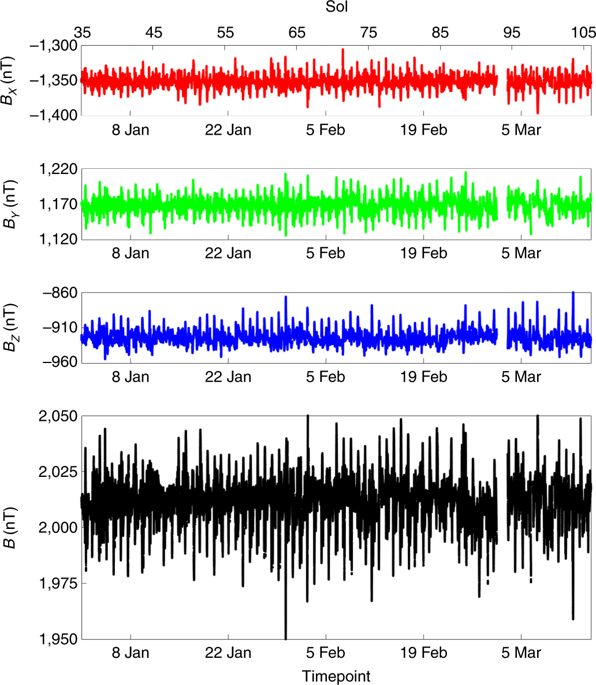Nature Geoscience ( IF 18.3 ) Pub Date : 2020-02-24 , DOI: 10.1038/s41561-020-0537-x Catherine L. Johnson , Anna Mittelholz , Benoit Langlais , Christopher T. Russell , Véronique Ansan , Don Banfield , Peter J. Chi , Matthew O. Fillingim , Francois Forget , Heidi Fuqua Haviland , Matthew Golombek , Steve Joy , Philippe Lognonné , Xinping Liu , Chloé Michaut , Lu Pan , Cathy Quantin-Nataf , Aymeric Spiga , Sabine Stanley , Shea N. Thorne , Mark A. Wieczorek , Yanan Yu , Suzanne E. Smrekar , William B. Banerdt

|
Magnetic fields provide a window into a planet’s interior structure and evolution, including its atmospheric and space environments. Satellites at Mars have measured crustal magnetic fields indicating an ancient dynamo. These crustal fields interact with the solar wind to generate transient fields and electric currents in Mars’s upper atmosphere. Surface magnetic field data play a key role in understanding these effects and the dynamo. Here we report measurements of magnetic field strength and direction at the InSight (Interior Exploration using Seismic Investigations, Geodesy and Heat Transport) landing site on Mars. We find that the field is ten times stronger than predicted by satellite-based models. We infer magnetized rocks beneath the surface, within ~150 km of the landing site, consistent with a past dynamo with Earth-like strength. Geological mapping and InSight seismic data suggest that much or all of the magnetization sources are carried in basement rocks, which are at least 3.9 billion years old and are overlain by between 200 m and ~10 km of lava flows and modified ancient terrain. Daily variations in the magnetic field indicate contributions from ionospheric currents at 120 km to 180 km altitude. Higher-frequency variations are also observed; their origin is unknown, but they probably propagate from even higher altitudes to the surface. We propose that the time-varying fields can be used to investigate the electrical conductivity structure of the martian interior.
中文翻译:

火星InSight着陆点的地壳和时变磁场
磁场为了解行星的内部结构和演化(包括大气和空间环境)提供了一个窗口。火星上的卫星测量了表明古代发电机的地壳磁场。这些地壳场与太阳风相互作用,在火星的高层大气中产生瞬变场和电流。表面磁场数据在理解这些效应和发电机中起着关键作用。在这里,我们报告了火星InSight(使用地震调查,大地测量学和热传输的内部勘探)着陆点的磁场强度和方向的测量结果。我们发现该领域比基于卫星的模型所预测的强十倍。我们推断出离着陆点约150公里以内的地表以下的磁化岩石,这与过去具有类似地球强度的发电机一样。地质测绘和InSight地震数据表明,大部分或所有磁化源都携带在至少39亿年前的基底岩石中,并覆盖了200 m至〜10 km的熔岩流和经过改良的古老地形。磁场的每日变化表明电离层电流在120 km至180 km高度处的贡献。还观察到更高的频率变化。它们的起源是未知的,但是它们可能从更高的高度传播到地面。我们建议时变场可以用来研究火星内部的电导率结构。已有90亿年的历史,被200 m至〜10 km的熔岩流和经改良的古老地形所覆盖。磁场的每日变化表明电离层电流在120 km至180 km高度处的贡献。还观察到更高的频率变化。它们的起源是未知的,但是它们可能从更高的高度传播到地面。我们建议时变场可以用来研究火星内部的电导率结构。已有90亿年的历史,被200 m至〜10 km的熔岩流和经改良的古老地形所覆盖。磁场的每日变化表明电离层电流在120 km至180 km高度处的贡献。还观察到更高的频率变化。它们的起源是未知的,但是它们可能从更高的高度传播到地面。我们建议时变场可以用来研究火星内部的电导率结构。



























 京公网安备 11010802027423号
京公网安备 11010802027423号